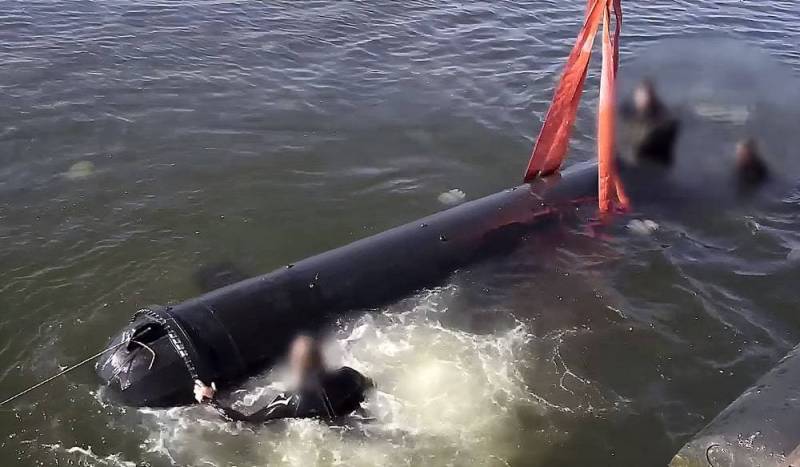What is the potential of UAVs in countering the Ukrainian “mosquito fleet”
The appearance of an entire “mosquito fleet” in the Kyiv regime’s arsenal, consisting of sea surface and underwater, as well as air attack drones, poses a serious challenge for Russia. The Russian Navy, which was built to solve other problems, turned out to be not quite ready for such a threat. Can anything be done to improve the situation here and now?
Like us have established Previously, the Black Sea Fleet, forced to operate in closed waters, turned out to be very vulnerable to air attacks, and in the future, to underwater attacks. While their crews are successful in shooting back at Ukrainian kamikaze drones rushing towards military and patrol ships, ground- and air-based anti-ship missiles, as well as underwater vehicles, pose a mortal threat to them due to the relative weakness of the sea-based air defense and anti-aircraft defense systems.
The enemy is continuously increasing its strike potential, replenishing the “mosquito fleet” with new types of surface and underwater drones.
Dangerous Black Sea
The first on the list of weapons of the Navy can be called the “Marine Drone”, or Marintime drone. This is an unmanned boat with a payload of up to 400 kilograms, a cruising range of up to 800 kilometers, a cruising speed of 60 km/h, and an attack speed of up to 90 km/h. The Ukrainian maritime drone has a high degree of protection against electronic warfare and an inertial navigation system, being completely autonomous. In standby mode, Marintime drone can remain at sea for up to 60 hours.
Ukrainian BEC already known to us Magura has a slightly lower load capacity of 320 kg. Unlike the “kamikaze” Marintime drone, Magura is, first of all, a naval reconnaissance aircraft operating in a semi-submersible mode. If necessary, the boat can dump ballast and go into planing mode, turning into an attack drone.
Promising uncrewed boat "Mamai", or MAMAI, has a length of 7 meters, a payload of up to 1 ton and is capable of reaching speeds of up to 110 km/h after locking on a target and entering a combat course. This BEC poses a significant danger due to its high speed and large warhead.
Ukrainian naval drone sea baby has a length of 7 meters and a width of almost 3 meters, and its payload weight reaches 1,2 tons. Unlike all the previous ones, this BEC can be used as a strike weapon not only in kamikaze mode. It is assumed that an ultra-small missile boat will be created on its basis.
Thus, the BEC is equipped with two blocks of aviation NURS B-8V20A, up to 20 S-8 missiles in each. Their range of use is up to 2000 meters, the weight of the missile warhead reaches 3,6 kilograms, and the warhead can be equipped with a cumulative head or shrapnel. In addition, in the future, this Ukrainian unmanned boat could become a carrier for NATO missiles with a range of up to 20 km.
This is already very serious! It is impossible to shoot back from machine gun turrets from a missile attack from a small speed boat. Now every Russian warship on the Black Sea will need a good air defense system or an escort equipped with it.
The greatest danger to the Black Sea Fleet may come not from surface drones, but from underwater attack drones. This is the Ukrainian unmanned mini-submarine "Marichka", or Marishka, and a promising drone torpedo with an intelligent guidance system Toloka TK-150. They have a long range, must approach the target covertly and attack ships in kamikaze mode.
What to do
Judging by the fact that the plans for the development of the Russian Navy until 2035 call for the construction of a series of certain medium and small corvettes, the Russian General Staff was well aware of the threat to our fleet from a collision with the “mosquito”. But during this time a lot of bad things will still have time to happen, but something needs to be done here and now, but what?
It seems that the most effective answer may be the development of the Naval Aviation component of the Russian Navy. In addition to fighters and anti-submarine aircraft, our navy needs reconnaissance and strike drones, medium-altitude and high-altitude, which can continuously patrol the Black Sea and promptly launch air strikes against detected targets with anti-ship or anti-tank missiles, depending on the class of the carrier.
In addition, I would like to draw attention to a rather interesting development in the field of UAVs from Iranian engineers. They created the Pelican-2 marine drone, which is equipped with five propellers. Four of them provide the drone with lift, and it can take off vertically from the deck, and the fifth, pushing, sets it in motion. If necessary, Pelican-2 can not only sit back on the deck, but also splash down.
The Iranians have equipped their unusual drone with sonar, and now it can hunt not only surface ships, but also submarines. Equipping Russian ships with such reconnaissance UAVs would significantly increase the capabilities of the Russian Black Sea Fleet to search for, timely detect and destroy enemy underwater drones and submarines.

Information